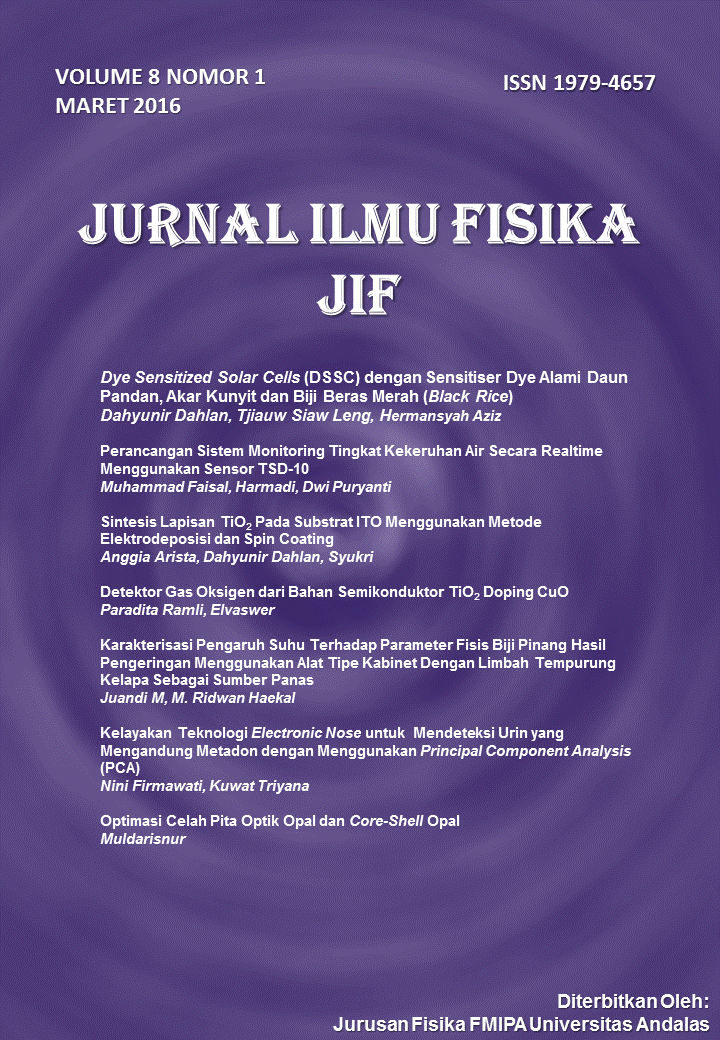Kelayakan Teknologi Electronic Nose untuk Mendeteksi Urin yang Mengandung Metadon dengan Menggunakan Principal Component Analysis (PCA)
DOI:
https://doi.org/10.25077/jif.8.1.45-51.2016Abstract
Telah dilakukan penelitian untuk menguji kelayakan teknologi electronic nose pada sampel urin yang mengandung metadon dengan urin yang tidak mengandung metadon dan air murni sebagai referensi. Sistem pengenalan pola yang digunakan adalah Principal Component Analysis (PCA). Berdasarkan penelitian yang dilakukan itu diperoleh bahwa hasil plot PCA menunjukkan adanya kecenderungan sampel yang sejenis mengelompok sesuai jenisnya. Kemampuan PCA dalam mengelompokkan data dari hasil luaran sensor gas tersebut menunjukkan bahwa electronic nose yang digunakan memiliki performa repeatibility yang baik dan layak digunakan sebagai alat pendeteksi urin yang mengandung metadon.
Downloads
References
Arshak, K., Moore, E., Lyons, G.M. and Clifford, S., 2004, A Review of Gas Sensors Employed in Electronic Nose Application, Emeral Group Publishing Limited. ISSN 0260-2288. DOI: https://doi.org/10.1108/02602280410525977
Bernabei, M., Pennazza, G., Santonico, M., Corsi, C., Roscioni, C., Paolesse, R., Natale, D. dan Amico, D 2008, A Preliminari Study on the Possibility to Diagnose Urinary Tract Cancers by an Electronic Nose, Sensors and Actuators B 131, 1-4 DOI: https://doi.org/10.1016/j.snb.2007.12.030
Charaklias, N., Raja, H., Humphreys, ML., Magan, N. dan Kendali, C.A., 2010, The Future of Early Disease Detection? Application of Electronic Nose Technology in Otolaryngology, The Journal of Laryngology & Otology, 124, 823-827. DOI: https://doi.org/10.1017/S002221511000112X
Dragonieri, S., Brinkman, P., Mouw, E., Zwinderman, A., Carratu, P., Resta, O., Sterk, P.J. dan Jonkers, R., 2013, An Electronic Nose Discriminates Exhaled Breath of Patients with Untreated Pulmonary Sarcoidosis from Controls, Respiratory Medicine 107, 1073-1078. DOI: https://doi.org/10.1016/j.rmed.2013.03.011
Dragonieri, S., Schee,M., Massaro, T., Schiavulli, N., Brinkman, P., Pinca. A., Caaratu, P., Spanevello, A., Resta, O., Musti, M. dan Sterk, P., 2012 An Electronic Nose Distinguishes Exhaled Breath of Patiens with Malignant Pleural Mesothelioma from Controls, Lung Cancer, 75, 326-331. DOI: https://doi.org/10.1016/j.lungcan.2011.08.009
Jun, W, Gomez, A.H., Hu, G. dan Pereira, A.G., 2007, Discrimination of Storange shelf-life formandarin by E-Nose Technique, ScienceDirect, LWT 40, 681-689. DOI: https://doi.org/10.1016/j.lwt.2006.03.010
Peris, M. dan Gilabert, L.E., 2009, A 21 st Century Technique for Food Control: Electronic Noses, Analytica Chimica Acta 638, 1-15. DOI: https://doi.org/10.1016/j.aca.2009.02.009
Tan dan Halim, A., 2012, Data Acquidition System Development of an Electronic Nose for Sulphate-reducing Bacteria Detection, International Conference on Intelligent and Advanced Systems. DOI: https://doi.org/10.1109/ICIAS.2012.6306079
Tian, X.Y., Cai, Q. dan Zhang, Y.M., 2012, Rapid Clasissification of Hairtail Fish and Pork Freshness Using an Electronic Nose Based on the PCA Method, Sensors, 260-277. DOI: https://doi.org/10.3390/s120100260
Turner, A.D.F. dan Magan, N., 2004, Electronic Nose and Disease Diagnosis, Microbiology, Volume 2, 161-165. DOI: https://doi.org/10.1038/nrmicro823
Zhang, M., Wang, X., Liu, Y., Xu, X. dan Zhou, G., 2012, Species Discrimination among Three Kinds of Puffer Fish Using an Electronic Nose Combined with Olfactory Sensory Evaluation, Sensor, Volume 12, 12562-12571. DOI: https://doi.org/10.3390/s120912562
Downloads
Published
How to Cite
Issue
Section
Citation Check
License
Please find the rights and licenses in JIF (Jurnal Ilmu Fisika).
1. License
The non-commercial use of the article will be governed by the Creative Commons Attribution license as currently displayed on Creative Commons Attribution-NonCommercial 4.0 International License.
2. Author's Warranties
The author warrants that the article is original, written by stated author(s), has not been published before, contains no unlawful statements, does not infringe the rights of others, is subject to copyright that is vested exclusively in the author and free of any third party rights, and that any necessary written permissions to quote from other sources have been obtained by the author(s).
3. User Rights
JIF's spirit is to disseminate articles published are as free as possible. Under the Creative Commons license, JIF permits users to copy, distribute, display, and perform the work for non-commercial purposes only. Users will also need to attribute authors and JIF on distributing works in the journal.
4. Rights of Authors
Authors retain the following rights:
- Copyright, and other proprietary rights relating to the article, such as patent rights,
- The right to use the substance of the article in future own works, including lectures and books,
- The right to reproduce the article for own purposes, provided the copies are not offered for sale,
- The right to self-archive the article.
5. Co-Authorship
If the article was jointly prepared by other authors, the signatory of this form warrants that he/she has been authorized by all co-authors to sign this agreement on their behalf, and agrees to inform his/her co-authors of the terms of this agreement.
6. Termination
This agreement can be terminated by the author or JIF upon two months's notice where the other party has materially breached this agreement and failed to remedy such breach within a month of being given the terminating party's notice requesting such breach to be remedied. No breach or violation of this agreement will cause this agreement or any license granted in it to terminate automatically or affect the definition of JIF.
7. Royalties
This agreement entitles the author to no royalties or other fees. To such extent as legally permissible, the author waives his or her right to collect royalties relative to the article in respect of any use of the article by JIF or its sublicensee.
8. Miscellaneous
JIF will publish the article (or have it published) in the journal if the article's editorial process is successfully completed and JIF or its sublicensee has become obligated to have the article published. JIF may conform the article to a style of punctuation, spelling, capitalization, referencing and usage that it deems appropriate. The author acknowledges that the article may be published so that it will be publicly accessible and such access will be free of charge for the readers.



